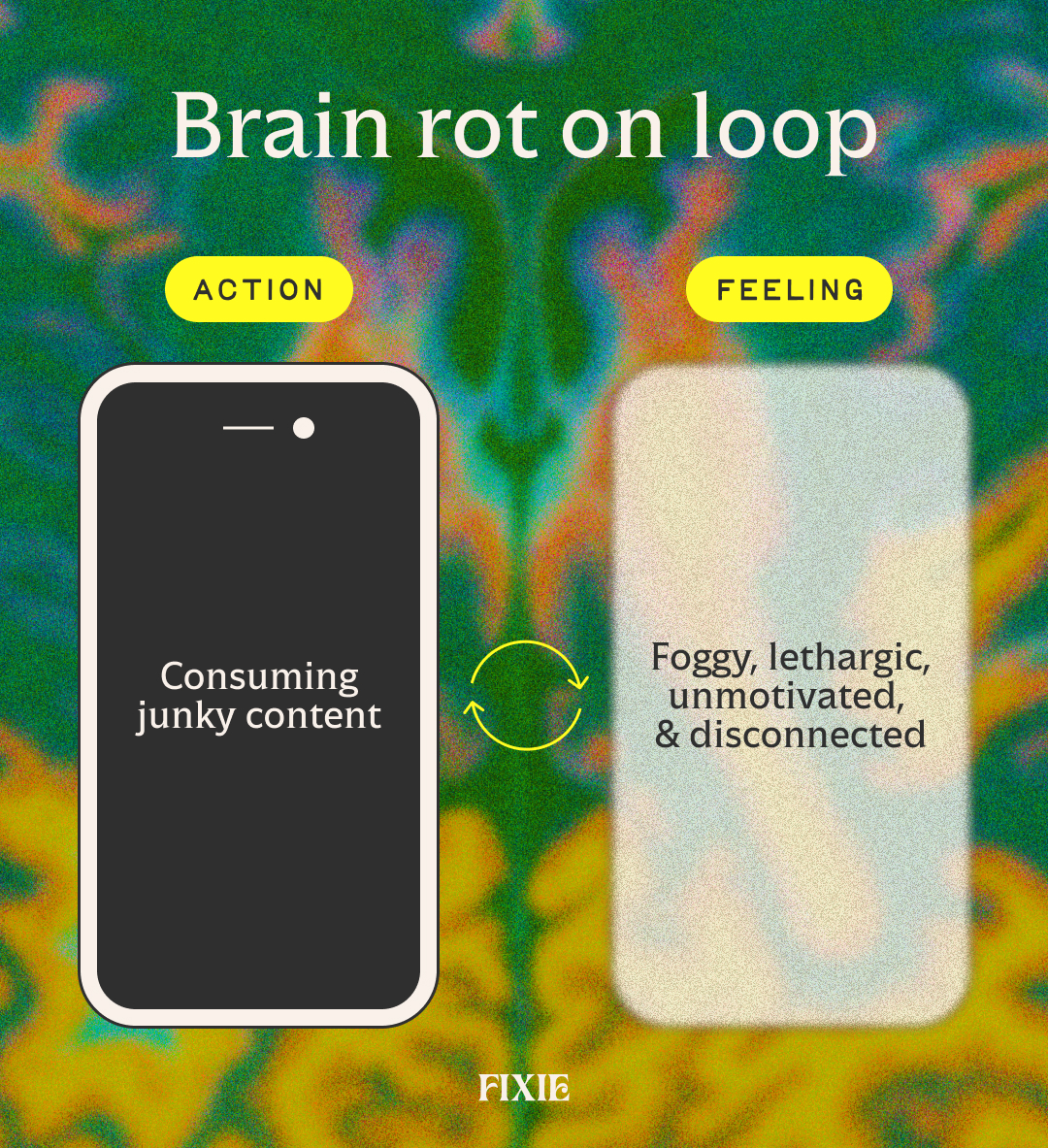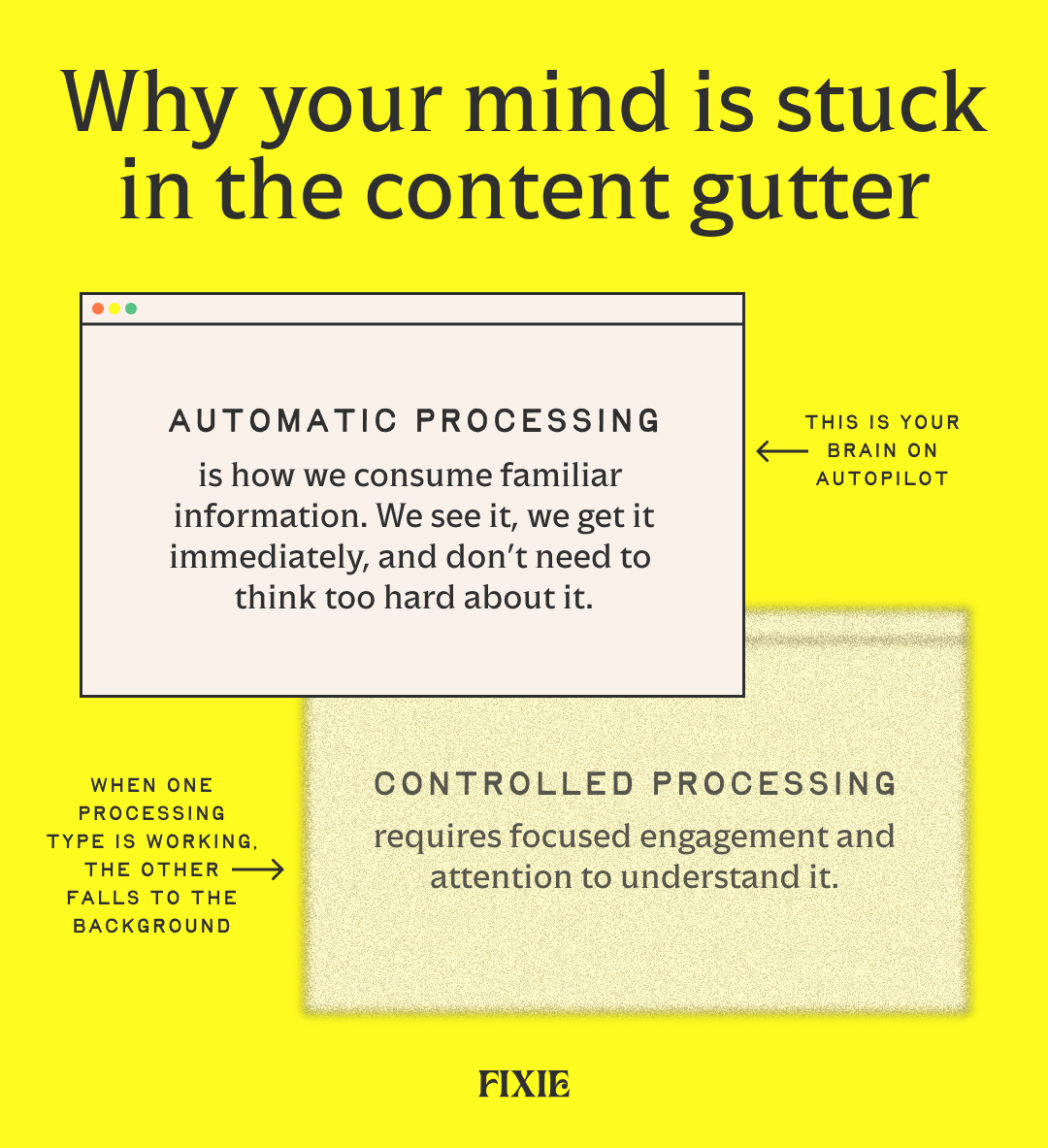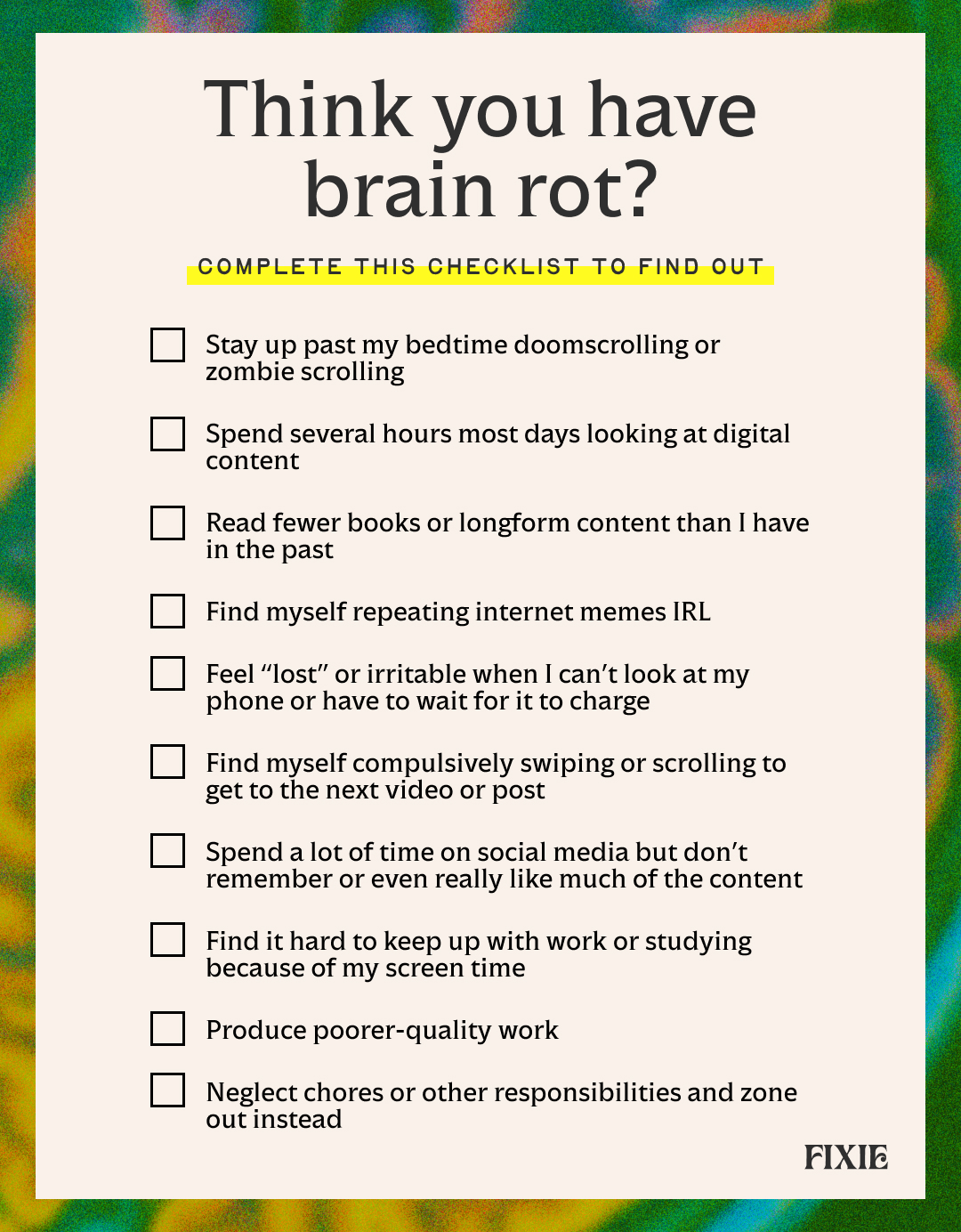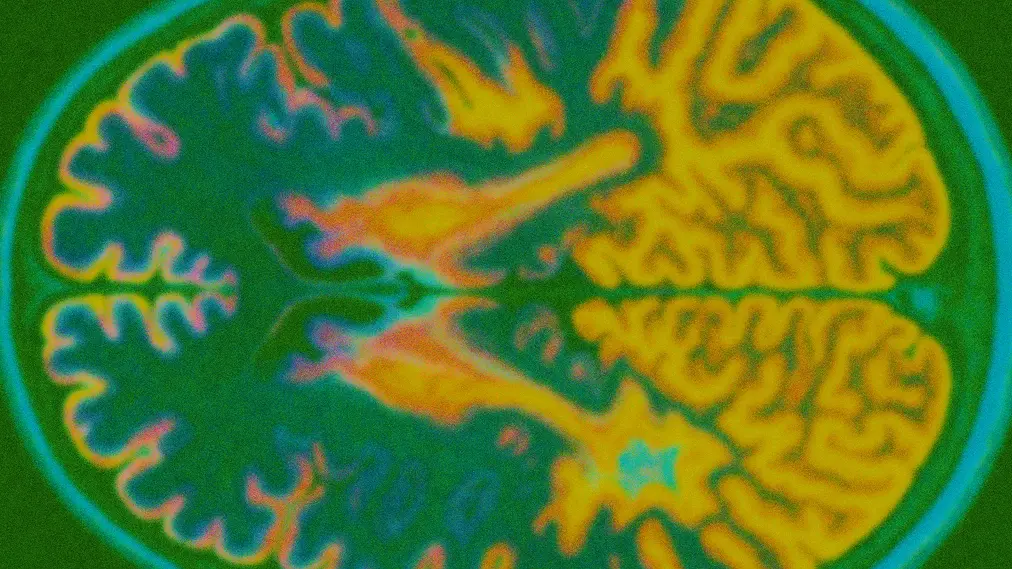What Is Brain Rot? Signs You’ve Got It (and How to Fix It)

Your brain isn’t literally rotting when you get stuck in scroll-mode or binge on mindless media junk—but sometimes it can feel that way. “Brain rot” might be a slang term, but the potential effects are serious and rooted in science. Here’s what we know about how excessive digital media consumption impacts the brain.
Look, I like a good long scroll sesh or Netflix binge as much as the next person. I’m a writer, a professor, and a single mom of two active and hungry boys, so there are plenty of days when I need some tune-out time. But this is also true: When I spend too much time swiping through social media, I don’t usually feel that great afterward.
Think of it this way: French fries are good. Pie is good. But too many fries or too much pie can quickly go from yum to yuck. The same goes for how we fill our brains. When we consume too much of the media and entertainment equivalent of junk food, it may feel great in the moment, but not so much afterward. We can develop something called brain rot.
So, what is brain rot anyway? “When people talk about brain rot, they’re usually describing a mental fog, restlessness, and general loss of focus that comes after endless scrolling or consuming quick-hit content,” explains Claudia Giolitti-Wright, M.A., L.M.F.T., a licensed marriage and family therapist and the founder and clinical director of Psychotherapy for Young Women. “It’s not a clinical term (yet!) but psychologically, it lines up with what we know about dopamine-seeking behaviors.”
We’re all susceptible to brain rot: teenagers, adults, parents, students, working professionals, anyone. Why? Because all of these groups have two things in common: access to devices and plenty of stress.
Brain rot is one part action and one part feeling. Consuming this sort of junky content for prolonged periods is Part One. Part Two is feeling foggy, lethargic, unmotivated, and disconnected afterward.

What does “brain rot” mean?
Brain rot is an internet slang term for bingeing low-effort (and often low-quality) content for an extended period of time and the resulting feelings afterward.
Quick note: There’s another kind of “brain rot”: Italian brainrot, the Gen Z TikTok meme language and silly AI-generated characters like Ballerina Cappuccina, which, yes, is a ballerina with a cup of cappuccino for her head, and no, I don’t know why.
“‘Brain rot’ doesn't refer to an actual health condition,” says Hannah Holmes, Ph.D., a psychologist and a clinical assistant professor at Appalachian State University in North Carolina. “It's more of a figurative term used to describe the way our minds and bodies are affected when we scroll mindlessly on social media.”
Typically, Holmes explains, brain rot content is addictive, short-form media that “seems to suck you in even if you're not really enjoying it,” like when you realize you’ve seen—but not really watched or cared about—4,000 TikToks in a row.
“Some people link it to dopamine,” Holmes says. “The reason this form of content can be so addictive is that it causes short dopamine bursts in the brain that initially feel good, but ultimately can be draining and overstimulating.”
But even if it’s not an actual diagnosis, brain rot is indeed a thing. The term was Oxford’s annual Word of the Year for 2024, and its usage grew in frequency by an estimated 230% between 2023 and 2024.
Even Oxford’s description addressed the real problems that may arise from this silly word: “Now also gaining momentum is a broader, more serious conversation about the potential negative impact that excessively consuming this content might have on mental health, particularly in children and young people.”
Is “brain rot” real?
In short, yes. It’s not literal rot or a real clinical diagnosis, but it is a real phenomenon with real consequences. I’ve definitely sat down at the end of a long day to wind down and “check” Instagram, only to snap out of a social-media trance—brain fuzzy, no real memory of the many Reels I’d just consumed, and an hour of my life swiped away.
“The brain is wired to chase novelty and reward,” Giolitti-Wright says. “That’s just a fact. So, apps like TikTok, Instagram Reels, and YouTube shorts are designed to deliver tiny bursts of entertainment or stimulation in rapid succession, and each swipe gives our brain a little dopamine spike, which makes it harder to put the phone down and easier to keep chasing that ‘just one more’ feeling.”
That sounds harmless enough at first, but when we keep seeking out these dopamine hits, we need more and more. “Over time, this cycle reshapes how the brain processes reward and attention,” Giolitti-Wright says.
“So, for example, things that used to feel naturally engaging, like reading, spending time outside, or even having a conversation, can feel ‘too slow’ compared to the pace of the feed. That’s the essence of brain rot: a kind of overstimulation that leaves you both wired and drained at the same time.”
But is all mindless scrolling technically brain rot? No, Giolitti-Wright says.
“Mindless scrolling or TV bingeing now and then is something most of us do,” she says. “It can be a way to unwind after a long day or just relax. The key here is that it's an intentional, temporary break and doesn't interfere with your life.”
You can slip into brain rot territory when that temporary break becomes prolonged and almost unconscious behavior. “You're no longer in control of the scrolling,” Giolitti-Wright says. “The scrolling is in control of you.”
Common “brain rot” symptoms people describe
Brain rot can make people feel foggy, overwhelmed, overstimulated, mentally drained or mentally tired.
“I've had clients tell me, ‘It's like my brain is buffering all the time’ or ‘It's like I'm moving through quicksand,’" Giolitti-Wright says.
Brain rot symptoms include:
- compulsive scrolling
- spending hours on-screen
- difficulty focusing on long-form tasks
- memory lapses
- sleep disruption
- anxiety when away from the mobile devices
- weakened ability to pay appropriate attention to valuable activities
Other behaviors include doomscrolling (consuming lots of negative news), “zombie” scrolling (mindless trance-like scrolling), and social media addiction, which are all linked to psychological distress, anxiety, and depression. These factors can erode executive functioning, memory, planning, and decision-making.

Effects of brain rot
Here are a few ways the screen scroll impacts your health:
- Poor sleep: “A nightly routine of endless, mindless scrolling can directly impact sleep by delaying bedtime,” Holmes says.
- Declining physical health: The more time you’re spending on TikTok, the less time you’re probably moving your body. “The lifestyle of a person experiencing brain rot can include a lack of movement, poor sleep, and even inadequate nutrition, which all contribute to a feeling of being unwell,” Giolitti-Wright says. “Chronic stress also releases cortisol and adrenaline, which can interfere with attention and executive function over time.”
- Feeling disconnected in relationships: “It disconnects us from others,” Holmes says. “We have all probably been in a room with loved ones where everyone is glued to their phone. While this may be a relaxing break occasionally, when it becomes a daily habit or consumes many hours a day, it can harm the health of our closest relationships.”
- Difficulty focusing: Flooding our brain with constant stimulation and information affects focus. “It burns cognitive fuel and leaves less room for focused thinking or memory retention,” Giolitti-Wright says. “You might notice it's harder to follow conversations, stay present at work, or even finish a simple book.”
- A negative mental state: “If you take a moment to check in with your mood and mental state while you're scrolling on social media, you may notice tension, irritability, or anxiety,” Holmes says. “While it may initially feel good to passively consume entertaining content, when our brains are bombarded with a new video every three to five seconds, it can eventually be overwhelming and stress-inducing.”
What causes brain rot?
Researchers have identified some of the causes of brain rot. The main one? Massive consumption of digital media, including streaming video, social media, and instant messaging.
Quick fact: College students spend an average of seven hours per day using mobile devices solely for entertainment purposes. This figure does not include time spent on them for academic purposes.
This consumption is often happening at lightning speed: quick scrolls and swipes between videos, switching between apps and tabs. This, paired with the frequency and volume of content, is a recipe for cognitive overload, lack of attention, and mental fatigue.
And once we start, it’s hard to stop. Social media and streaming apps are designed to keep us on their platforms, so their algorithms continue to show us content it thinks will achieve that.
Your brain on autopilot
There’s also a psychological explanation for why it’s hard to get our minds out of the content gutter once they’re in there. It’s a little technical, so let’s break it down.
There’s something called the dual process theory. This says there are two ways we process information: automatic processing and controlled processing.
- Automatic processing is how we consume familiar information. We see it, we get it immediately, and don’t need to think too hard about it. Think of it as brain autopilot.
- Controlled processing, though, requires focused engagement and attention to understand it. Think of it more like a pilot flying a plane through a patch of turbulence.
Only one type of information processing is happening in our brains at once when we read, hear, or watch something. When one processing type is working, the other falls to the background. Researchers have said because short videos and similar content don’t require much thinking or cognitive engagement, automatic processing takes over. Our brains are on autopilot.

Why can’t I stop scrolling?
“The behaviors associated with brain rot are almost always a coping mechanism,” says Giolitti-Wright. “It's a way to emotionally shut down or have a buffer against overwhelming feelings you can't yet name. So, in other words, it's a strategy for emotional avoidance. People with avoidant tendencies or personality traits can be very prone to it.”
Giolitti-Wright says many of her clients have high-functioning anxiety. “They're smart, driven women who ‘push through’ despite their exhaustion, only to find themselves emotionally and cognitively depleted,” she says. “The constant state of worry and hypervigilance is neurologically draining, so their brain essentially goes into fog mode as a form of protection.”
Brain rot vs. “brain decay”
This is an important distinction: Brain rot is not a neurodegenerative disease, like dementia. It’s not a biological condition (as far as we know, now). And there’s no evidence to suggest a direct link between brain rot and brain conditions.
But there has been research on excessive screen time’s effects on the brain and cognition. Some research has found heavy TV viewing was associated with an increased risk of dementia, Parkinson’s disease, and depression.
The same study found chronic digital stimulation from excessive screen time can affect brain development in adolescents and young adults, which increases the risk of emotional, cognitive, and behavioral disorders. Excessive screen time can also alter gray and white matter in the brain, impair learning and memory, and increase the risk of mental illness.
Who’s most at risk?
We tend to associate brain rot with teens and young adults, and that’s certainly true. Heavy screen usage and immersion in Internet meme culture are likely perfect breeding grounds for it. But anyone can fall victim to brain rot.
It might come as a surprise, but Giolitti-Wright sees brain rot most commonly in high-achieving young adults, aged 20 to 30. This group is often navigating major life "firsts,” she says: jobs, relationships, financial responsibilities, children. They also juggle career pressure, social comparison, and the pressure to be "on" all the time
“This constant change and high-stakes environment naturally increase anxiety, making them more susceptible to using digital distraction as a quick, accessible coping tool,” she says.
How to reverse brain rot
It may take some doing, but you can get out of the brain rot rut. Here are some recommendations from the experts:
- Notice how you feel when you scroll: “Once you tune in, you may notice that you aren't actually enjoying it all that much, which can make it easier to disengage from the phone and engage in other activities that bring you real rest or enjoyment,” Holmes says.
- Move your body: “Physical activity helps us feel more physically and mentally alert, and it re-engages you with your physical surroundings, which can be very grounding,” Holmes says.
- Add “friction”: Make it harder to mindlessly scroll by removing certain time-suck apps from your phone (at least temporarily) or logging out of them each time. “That moment of hesitation can be a powerful opportunity to ask, ‘Do I really want to do this right now, or am I just on autopilot?’” Giolitti-Wright says. “It's a simple way to interrupt the cycle of unconscious behavior.”
- Opt for longer content: Instead of hopping from one short video to the next (and the next), watch longer, more intentional content that holds your attention for more than a millisecond. “Longer forms of content—-rather than jumping from reel to reel-—-can be more restful for your brain,” Holmes says.
Revamp your routines: For a lot of us, checking our phone is the first thing we do in the morning and the last thing we do at night. Create new morning and nighttime rituals so that screen isn’t your priority. “These intentional, screen-free activities can help you start your day with a sense of calm and end it by truly winding down,” Giolitti-Wright says. “Delay opening your apps and find new anchors to enter and exit your days.”
Quick Tip: For a quick way to make your phone less appealing, change the settings to grayscale. Scrolling on a black and white phone is just not as much fun, and researchers have found that removing color from the scroll resulted in a 38-minute reduction in screentime per day.
For parents and caregivers
If you’re concerned your kids could slide down the brain rot slope, here are some recommended prevention tips from the American Academy of Child & Adolescent Psychiatry (AACAP) and the American Academy of Pediatrics (AAP)(these are good tips for grown-ups, too):
- Quality matters. Consider the quality of the screen time, not just the quantity. Using a computer for homework isn’t the same as watching hours of YouTube shorts.
- Set reasonable limits: Neither the AACAP nor the AAP has strict time-limit recommendations per age, but try to limit screen-based activities.
- Stay connected: Turn off screens during family meals and outings.
- Instead of taking screens away, pack in activities and routines that leave less time for screens, like a regular post-dinner walk or game or a longer bedtime wind-down.
- Educate yourself: Learn about and use parental controls.
- Practice sleep hygiene: Turn off kids’ screens 30 to 60 minutes before bedtime and remove them from their bedrooms.
- Stay involved: Pay attention to the content your child sees to make sure it’s appropriate. Discuss the content together.
- Keep them active: Encourage your child to engage in screen-free activities, like sports, music, art, and other hobbies.
- Set an example: Be mindful of your own screen habits so you can set a good example.
- Put it in writing: Create a family media plan so everyone is on the same page. The AAP has a fillable template.
Quick self-check
Think you might have a case of brain rot? Complete this checklist to find out.
Note from our medical reviewers: this self-check quiz is not diagnostic of any medical condition, but rather a tool for self-reflection as it pertains to one’s digital habits.

When to seek help
If you find that your screen habits are starting to affect your daily life, that’s a red flag that you should reach out to a clinician or therapist. It’s time to talk to a doc if:
- your work or school performance is slipping
- your relationships with your partner, kids, friends, family, or coworkers are becoming strained
- you’re experiencing sleep problems
- you have persistent low mood, or if you suspect a condition such as ADHD, depression, or anxiety
- you feel like you’re “addicted” to social media or other digital content
- you feel like your screen usage is a coping mechanism or zone-out tool to avoid other issues
The bottom line
Brain rot isn’t an actual clinical diagnosis, but it is a legitimate problem. If you feel like you’re on autopilot and spending too much time doomscrolling or zombie scrolling, you might have brain rot. Anyone who spends a lot of time consuming digital media is susceptible to brain rot, but there are steps you can take to either prevent it or reverse it. As a busy working mom, I plan to be more mindful of my kids’ screen time—and my own—to keep the rot away.
Key takeaways
- “Brain rot” is a slang term, but it's a real experience.
- Brain rot comes from consuming lots of low-effort, low-quality, and often short-form digital content for prolonged periods of time.
- Brain rot is not a formal clinical diagnosis. It’s also not the same thing as brain “decay,” nor is it a neurodegenerative condition.
- Brain rot also refers to feelings of mental fatigue and fog, low mood, and lethargy after a lot of time consuming social media and other digital content.
- Brain rot is both preventable and reversible.
Frequently Asked Questions
Brain rot is Internet slang for bingeing low-effort (and often low-quality) content for an extended period of time and the resulting feelings of mental fatigue and fogginess afterward.
Brain rot is both the behavior of consuming lots of low-quality, short-form digital content and also the feelings afterward.
Yes. It’s not a formal clinical diagnosis or condition, but it is a real thing people experience.
Brain rot can refer to consuming lots of digital media content at one time without really thinking about it. It can also refer to “Italian brainrot”: a Gen Z Internet meme “language” and AI-generated characters.
An example of brain rot is staying up past your bedtime and watching YouTube shorts or TikTok videos one after the other on autopilot.
Brain rot isn’t the same as mindless digital brain breaks. Brain rot is a pattern of consuming low-quality, low-interaction digital content (mostly on social media) for long periods of time. Brain rot also affects our mood, motivation, and mental clarity.
Brain rot can create feelings of mental fog, restlessness, and a general loss of focus after endless scrolling. It could potentially affect your sleep and make you feel both physically and mentally fatigued.
Latest Posts







.svg)



